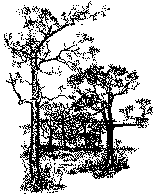1995 Midwest Oak Savanna and Woodland Ecosystems Conferences
Appendix D
The following lists of indicator plant species is an example of efforts to
aid in the identification of remnants of oak savannas and oak woodlands. Such
lists help provide "search images" for highly restorable remnants. Biologists in
other eco-regions should consider publishing locally appropriate lists. |
 |
INDICATOR PLANT SPECIES OF RECOVERABLE OAK SAVANNAS AND OPEN OAK WOODLANDS IN
SOUTHERN WISCONSIN
by Brian W. Pruka1
Several Wisconsin botanists have developed a list of indicator species
to help restorationists identify savanna (10-50 percent canopy) and open
oak woodland (50-80 percent canopy) remnants. I and my colleagues--Brian
Bader, Ted Cochrane, Eric Epstein, Rich Henderson, Randy Hoffman, and Mark
Leach--believe that the presence of these light-dependent understory species
indicates a recent closure of the canopy. Wooded sites containing sufficient
populations of these species, therefore, have the highest potential for
recovery if properly managed through the use of prescribed burns, mechanical
canopy thinning, and other techniques.
This list, although preliminary, should be useful to restorationists
in southern Wisconsin, and in the neighboring regions of southeastern Minnesota,
northeastern Iowa and northern Illinois. I anticipate that we will refine
it to provide separate indicator species lists for oak openings, oak barrens,
and open oak woodlands. For now, it should serve field investigators who
are attempting to identify and assess remnant sites for their restoration
potential.
This list consists of four categories of identification.
Category 1
species are the best indicators of former savannas and open woodlands because
they tend to be limited to partial canopy conditions. In more densely-wooded
sites, these species are usually in a state of declining vigor due to the
ever-increasing canopy closure. They typically persist in densely-wooded
sites only near canopy openings such as woodlot edges, roadsides, or brushed
utility corridors.
Category 2 species
are moderate indicators of former savannas and/or open woodlands. Commonly
found under partial canopies, they are also important parts of either prairies
or forests, being more common in those communities than category 1 species.
Category 3 species are marginal indicators of former savannas and/or woodlands.
They tend to have broad habitat amplitudes that allow them to grow in several
upland plant communities.
Category 4
species are tentatively proposed as indicators of former savannas and/or
open woodlands. Due to our lack of sufficient experience with these species,
we chose to list them in a separate category. Further field investigations
should help place these species in one of the other categories.
Category 1 Species--Best
Indicators
|
Agastache nepetoides |
Yellow giant hyssop |
|
Agastache scrophularieaefolia |
Purple giant hyssop |
|
Anemone virginiana |
Tall anemone |
|
Asclepias purpurascens |
Purple milkweed |
|
Aster linariifolias |
Flax-leaved aster |
|
Astragalus canadensis |
Canadian milkvetch |
|
Aureolaria grandiflora |
Yellow false foxglove |
|
Aureolaria pedicularia |
Clammy false foxglove |
|
Baptisia leucantha |
White wild indigo |
|
Baptisia leucophaea |
Cream wild indigo |
|
Besseya bullii |
Kitten tails |
|
Blephilia ciliata |
Ohio horse-mint |
|
Bromus kalmii |
Prairie brome |
|
Cacalia atriplicifolia |
Pale Indian plantain |
|
Cacalia muhlenbergii |
Great Indian plantain |
|
Camassia scilloides |
Wild hyacinth |
|
Castilleja occinea |
Indian paintbrush |
|
Ceanothus americana |
New Jersey tea |
|
Ceanothus ovatus |
Prairie redroot |
|
Cirsium altissimum |
Woodland thistle |
|
Convolvulus spithamaeus |
Low bindweed |
|
Cypripedium pubescens |
Large yellow lady-slipper |
|
Desmodium canadense |
Showy tick-trefoil |
|
Dodecatheon meadia |
Shooting star |
|
Elymus villosus |
Silky wild rye |
|
Elymus virginicus |
Virginia wild rye |
|
Erigeron pulchellus |
Robin's plantain |
|
Eupatorium sessilifolium |
Woodland boneset |
|
Gentiana alba |
Cream gentian |
|
Heuchera americana |
Prairie alum-root |
|
Hieracium candense |
Canada hawkweed |
|
Hypoxis hirsuta |
Yellow star-grass |
|
Krigia biflora |
False dandelion |
|
Lilium philadelphicum |
Prairie lily |
|
Lysimachia lanceolata |
Lance-leaved loosestrife |
|
Lysimachia quadrifolia |
Whorled loosestrife |
|
Oenothera perennis |
Small sundrops |
|
Oxalis violacea |
Violet wood-sorrel |
|
Pedicularis canadensis |
Wood betony |
|
Penstemon gracilis |
Slender beard-tongue |
|
Phlox pilosa |
Prairie phlox |
|
Polemonium reptans |
Jacob's ladder |
|
Polygala senega |
Seneca snakeroot |
|
Polytaenia nutallii |
Prairie parsley |
|
Prenanthes alba |
Lion's foot |
|
Ranunculus fascicularis |
Early buttercup |
|
Ranunculus rhomboideus |
Prairie buttercup |
|
Silene stellata |
Starry campion |
|
Solidago hispida |
Hairy goldenrod |
|
Taenidia integerrima |
Yellow pimpernel |
|
Tephrosia virginiana |
Goat's rue |
|
Thaspium trifoliatum |
Meadow parsnip |
|
Tomanthera auriculata |
Eared false foxglove |
|
Triosteum aurantiacum |
Late horse gentian |
|
Triosteum perfoliatum |
Early horse gentian |
|
Veronicastrum virginicum |
Culver's root |
|
Zigadenus elegans |
White camas |
|
Zizia aurea |
Golden Alexander |
Category 2 Species--Moderate
Indicators
|
Allium cernuum |
Nodding wild onion |
|
Amorpha canescens |
Lead-plant |
|
Andropogon gerardi |
Big bluestem |
|
Andropogon scoparius |
Little bluestem |
|
Anemone cylindrica |
Thimbleweed |
|
Anemone patens |
Pasque flower |
|
Anemone quinquefolia |
Wood anemone |
|
Anemonellla thalictroides |
Rue anemone |
|
Arenaria lateriflora |
Wood sandwort |
|
Asclepias amplexicaulis |
Sand milkweed |
|
Asclepias exaltata |
Poke milkweed |
|
Asclepias tuberosa |
Butterfly milkweed |
|
Asclepias viridiflora |
Short green milkweed |
|
Aster azureus |
Sky-blue aster |
|
Aster laevis |
Smooth blue aster |
|
Aster sericeus |
Silky aster |
|
Aster shortii |
Short's aster |
|
Bouteloua curtipendula |
Side oats grama |
|
Bouteloua hirsuta |
Hairy grama grass |
|
Bromus ciliatus |
Fringed brome |
|
Cacalia suaveolens |
Sweet Indian plantain |
|
Callirhoe triangulata |
Clustered poppy mallow |
|
Carex brevior |
Sedge |
|
Cassia fasciculata |
Partridge pea |
|
Comandra umbellata |
False toadflax |
|
Coreopsis palmata |
Prairie tickseed |
|
Desmodium cuspidatum |
Bracted tick-trefoil |
|
Eupatorium purpureum |
Purple joe-pye weed |
|
Euphorbia corollata |
Flowering spurge |
|
Galium boreale |
Northern bedstraw |
|
Galium circaezans |
Wild licorice |
|
Gentiana puberulenta |
Downy gentian |
|
Gentiana quinquefolia |
Stiff gentian |
|
Geum triflorum |
Prairie smoke |
|
Helianthemum bicknellii |
Rockrose |
|
Helianthemum canadense |
Common rockrose |
|
Helianthus laetiflorus |
Prairie sunflower |
|
Helianthus occidentalis |
Western sunflower |
|
Hieracium scabrum |
Rough hawkweed |
|
Hystrix patula |
Bottlebrush grass |
|
Lathyrus venosus |
Woodland pea |
|
Leersia virginica |
White grass |
|
Liatris cylindracea |
Cylindrical blazing star |
|
Liatris ligulistylis |
Showy blazing star |
|
Lithospermum canescens |
Hoary puccoon |
|
Lithospermum caroliniense |
Hairy puccoon |
|
Lithospermum incisum |
Fringed puccoon |
|
Lobelia spicata |
Pale spiked lobelia |
|
Luzula multiflora |
Common wood-rush |
|
Orobanche uniflora |
One-flowered broom-rape |
|
Panicum latifolium |
Broad-leaved panic-grass |
|
Panicum linearifolium |
Slender-leaved panic-grass |
|
Penstemon pallidus |
Pale beard-tongue |
|
Petalostemum candidum |
White prairie clover |
|
Potentilla arguta |
Prairie cinquefoil |
|
Pycnanthemum virginianum |
Common mountain mint |
|
Solidago nemoralis |
Old-field goldenrod |
|
Solidago speciosa |
Showy goldenrod |
|
Sorghastrum nutans |
Indian grass |
|
Sporobolus heterolepis |
Prairie dropseed grass |
|
Viola pedatifida |
Prairie violet |
Category 3 Species--Associate Spp./Weak Indicators
|
Actaea pachypoda |
White baneberry |
|
Agrimonia gryposepala |
Tall agrimony |
|
Agropyron trachycaulum |
Slender wheatgrass |
|
Amphicarpa bracteata |
Hog peanut |
|
Apocynum androsaemifolium |
Spreading dogbane |
|
Apocynum cannabinum |
Indian hemp |
|
Brachyelytrum erectum |
Long-awned wood grass |
|
Galium concinnum |
Shining bedstraw |
|
Helianthus hirsutus |
Oblong sunflower |
|
Hieracium longipilum |
Hairy hawkweed |
|
Koeleria cristata |
June grass |
|
Kuhnia eupatorioides |
False boneset |
|
Lathyrus ochroleucus |
Pale pea |
|
Lechea intermedia |
Intermediate pinweed |
|
Lechea tenuifolia |
Slender-leaved pinweed |
|
Liatris aspera |
Rough blazing star |
|
Liatris pychnostachya |
Prairie blazing star |
|
Lysimachia quadriflora |
Narrow-leaved loosestrife |
|
Oryzopis racemosa |
Black-seeded ricegrass |
|
Panicum oligosanthes var. scribnerianum |
Few-flowered panic-grass |
|
Panicum lanuginosum var. implicatum |
Hairy panic-grass |
|
Petalostemum purpureum |
Purple prairie clover |
|
Polygala sanguinea |
Field milkwort |
|
Ratibida pinnata |
Yellow coneflower |
|
Rudbeckia hirta |
Black-eyed Susan |
|
Sisyrinchium campestre |
Prairie blue-eyed grass |
|
Smilacina stellata |
Starry false Solomon's seal |
|
Solidago juncea |
Early goldenrod |
|
Solidago rigida |
Stiff goldenrod |
|
Solidago ulmifolia |
Elm-leaved golden rod |
|
Tradescantia ohiensis |
Common spiderwort |
|
Uvularia grandiflora |
Bellwort |
|
Viola pedata |
Bird's foot violet |
Category 4 Species--Proposed
Indicators
|
Agrostis perennans |
Autumn bentgrass |
|
Asplenium platyneuron |
Ebony spleenwort |
|
Bromus purgans |
Woodland brome |
|
Carex rugosperma |
a sedge |
|
Corallorhiza odontorhiza |
Late coral-root |
|
Desmodium canescens |
a tick-trefoil |
|
Helianthus decapetalus |
Pale sunflower |
|
Lactuca floridana |
Woodland blue lettuce |
|
Lactuca ludoviciana |
Western prairie lettuce |
|
Lespedeza violacea |
Violet bush clover |
|
Polygala verticillata |
Whorled milkwort |
|
Silene antirrhina |
Sleepy catchfly |
|
Symphoricarpos occidentalis |
Wolfberry |
|
Trillium recurvatum |
Red trillium |
|
Vicia americana |
American vetch |
|
Vicia caroliniana |
Wood vetch |
1 Adapted from Pruka (1995) with
permission of author and Restoration & Management Notes. |

